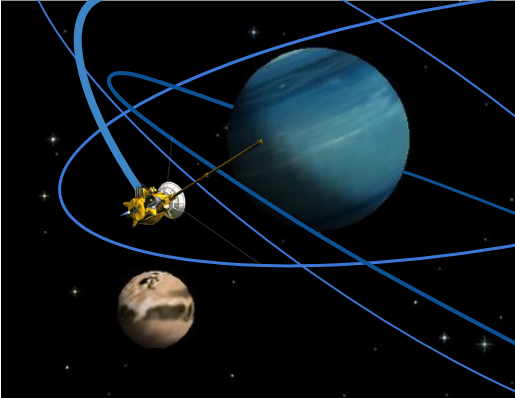Projects
Mission Operations Planning for Increasingly Autonomous Spacecraft

Excerpt of Neptune Odyssey tour
Credit: Image from JPL
Background
Future spaceflight missions will employ advanced onboard autonomy capabilities, including autonomous fault management, planning, scheduling, and execution, selection of scientific targets, and data summarization and compression.
Such autonomy technologies hold promise to enable missions that cannot be operated through a regular ground-in-the-loop operations cycle due to communication bandwidth and latency constraints and limited lifetime, including flybys of outer planets and surface operations in adverse environments; in addition, they could also increase science returns, improve spacecraft reliability, and reduce operation costs. As a compelling example, autonomy has already significantly increased the capabilities of Mars rover missions, enabling them to perform autonomous long-distance navigation and autonomous data collection on new science targets.
However, the challenge of operating such onboard autonomous capabilities and integrating them in ground operations has never been studied to a level of detail sufficient for consideration in mission concepts. To enable scientists and engineers to operate autonomous spacecraft, new operations tools and workflows must be developed. Uplink teams must communicate their science and engineering intent to onboard planning and autonomous science software, and assess the likely impact of such intent on the spacecraft state. Downlink teams, in turn, must explain what decisions were made by autonomy, reconstruct what happened on board, and identify anomalies that may otherwise be hidden by autonomous decisions. We leverage existing work being done with M2020 onboard planner on intent capture (the Copilot and Cocpit systems), on assessing likely impact with respect to activity duration variability (the Copilot system), and on explanation of generated schedules (the Crosscheck system). In this effort we focus on a more general, multi-mission architecture that builds upon M2020 onboard planner work.
Technology
We develop a set of tools and workflows to address these challenges, and we apply them to a realistic mission concept representative of a future ice giant tour mission.
The proposed uplink tools and workflows (effort led by Dr. Tiago Vaquero from the AI Group) leverage modeling technology that facilitates an iterative design process of science intent, including capturing intent and constructing plans with that intent. We focus on workflows for outcome/execution prediction, visualization, explanation, as well as advisory techniques (e.g., “to fix undesirable behavior, add/change this constraint”), to facilitate the operators’ learning process, while helping reassure them that the spacecraft will achieve the target intents and complete the plan successfully.
The proposed downlink tools and workflows (effort led by Dr. Federico Rossi and Dr. Vandi Verma) focus on two thrusts. The first thrust is spacecraft state estimation and propagation, a challenging problem in presence of on board autonomy, which may alter the spacecraft state in response to information that is not immediately available on the ground. The second thrust is explanation of the decisions taken by on-board autonomy, through user interfaces that capture what decisions were made by autonomy, and relate why the decisions were made to the intent provided by ground operators, the spacecraft state (including possible anomalies), and the perceived state of the environment.
We evaluate the proposed tools through user studies in realistic mission scenarios inspired by a notional ice giant tour mission (science rich, but power and telecom limited).
Impact
We envision that the developed tools, workflows, and lessons learned will directly inform future science and exploration missions across a variety of mission classes, including surface missions (e.g., Europa and other Icy World Lander, Mars Sample Return, and Venus Lander), small body exploration (e.g., fast flybys, Centaur rendezvous), and farther out concepts.
Status
This effort is a Strategic Initiative within the Research and Technology Development Program and is scheduled for FY2020 - FY2023.
Publications
Team
All members of the team are from Jet Propulsion Laboratory, California Institute of Technology.Initiative lead: Rebecca Castano
Project Leads:
- Tiago Vaquero (Uplink)
- Federico Rossi (Downlink)
- Vandi Verma (Downlink)
Science Advisors:
- Julie Castillo-Rogez
- Mathieu Choukroun
- Mark Hofstadter
Uplink Team:
- Rashied Amini
- Nihal Dhamani
- Raymond Francis
- Bennett Huffman
- Gregg Rabideau
- Ellen van Wyk
Downlink Team:
- Daniel Allard,
- Anthony. Barrett,
- Mitchel Ingham
- Ashkan Jasour
- Marijke Jorritsma
